In October, 1855 the Sacramento Union ran an advertisement announcing the formation of a new assaying firm under the partnership of Harvey Harris, Desiré Marchand, and C. Farrington. Harris, a gentile who had come to America from his native Denmark, had formerly been an assayer in the New
Orleans and San Francisco Mints and before removing to Sacramento had worked as an assayer for Kellogg & Company and Justh & Hunter. Harris and Marchand remained partners for nearly the next four years, dissolving the business relationship in the end of the third quarter of 1859. When he left the partnership Harris copied the shape and style of Marchand’s official Paris Mint assayer’s stamp and used it to mark his own bars. Harris’ stamp is preserved in the Carson City Mint Museum.
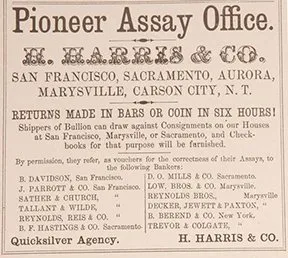
Harvey Harris a Danish immigrant came to the United States in 1840. Heading west he worked at the New Orleans Mint and like many heard the siren of California Gold beckoning. By way of Central America, he arrived at San Francisco just in time for the opening of the West’s first Mint. Quickly realizing that the mint was not responding to the business demanded by the California Gold Rush, Harvey established an Assay Office in Sacramento. His business grew with Hard Rock mining and additional offices were opened in Sacramento and Marysville. In 1860 Silver discoveries in the Washoe region of the Utah Territory led Harvey to what would later become the Comstock Lode in Nevada. Business boomed, and he established offices in Aurora and Carson City early in 1862. Two more Nevada offices followed, in Silver City and finally Gold Hill. There he lived out his years becoming a Vice Consul to Denmark.
Harvey Harris died in Gold Hill in 1894 at the age of eighty years. He was a pioneer resident of the Comstock and Silver City where he arrived in 1859
and had an assay office in Gold Hill for many years. He was a native of Denmark and served that country as Consul for Nevada for nearly three decades.
13.10 oz Harvey Harris, Assayer. Gold Hill or Silver City, Nevada. Silver & gold presentation assay ingot no. 2128.
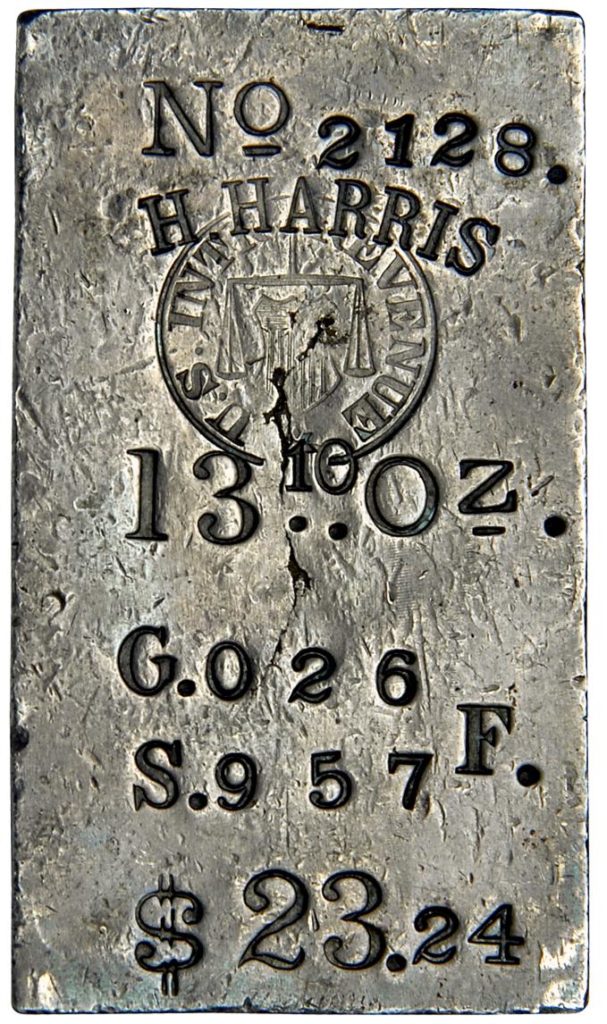
Overall appearance of Very Fine to Extremely Fine. A well made ingot with squared off edges and sharp corners. Surfaces probably originally polished thus the decision to classify this as a presentation ingot although its present appearance is none too winsome. Medium gray color. Minor surface flaws on the face. Harris worked as an assayer both in Gold Hill and Silver City during 1864-72. The stamp of the Office of Internal Revenue only corresponds with this dating and cannot refine it. On this bar, the ethnic (i.e., maker’s name) and the bar’s gross weight have been stamped over the OIR punch.
The assayer clearly had the bar’s weight and value already worked out on paper before he came to stamping the bar as required by law. One may also be fairly certain that Harris did not intend to make the bar look any more presentable than it does, now. Had this been a Blake & Company ingot the layout would have been more symmetrical. Note there are no corner clips on this bar. Extremely rare, the cataloguer has records of only a handful of Harris bars. Kleeberg listed six he considered to be genuine, to which the cataloguer can add another in the second lot to follow. Unlike the present bar, most of Harris’ ingots show his distinctive assayer’s stamp, copied from the one Marchand used on their earlier joint products. On Harris’s stamp, the letters “H” lack a complete crossbar.
This Harvey Harris bar was published by Edgar H. Adams in the September, 1911 issue of The Numismatist in his “Live American Numismatic Items”. Adams wrote, in part: “Mr. S.D. Kiger, now of Portland, Oregon, reports the acquisition of two very interesting pieces…He states that the pieces had been in the possession of the family from whom he obtained them for nearly fifty years, and they were originally owned by J.W. Wright of the State Bank of California. Mr. Kiger learns that the slugs were used as money at Pioch and Virginia City, Nev.” Adams illustrated the face and right side of the Harris bar in the notice.
He mentioned a second item obtained by Mr. Kiger and illustrated a bar that has a $6.25 value and 965 fineness stamped on it, but no ethnic. It is interesting to note that this bar, which may be dated after September, 1864 by the presence of the OIR stamp, is numbered 2128, yet the bar to follow, dated on the bar August 1864, is numbered 2685. Perhaps Harris maintained two record books?
Face: No2128. / H.HARRIS / OIR stamp / 13..10 OZ. / G.026 F.[vertically between this and next] / S.957 / $23.24.
- Back: blank.
- Top side: blank.
- Bottom side: blank.
- Left side: blank.
- Right side: blank.
- Dimensions: 68.8 x 39.0 x 14.5 mm.
- Stated weight: 13.1 ozs
From the John J. Ford, Jr. Collection
[10/2007] https://auctions.stacksbowers.com/lots/view/3-AV6MD/harvey-harris-assayer-gold-hill-or-silver-city-nevada-silver-gold-presentation-assay-ingot-no-2128 ($37,375)
12.20 oz Harvey Harris, Assayer. Gold Hill, Nevada Territory. Silver & gold presentation assay ingot number 2685, August, 1864.
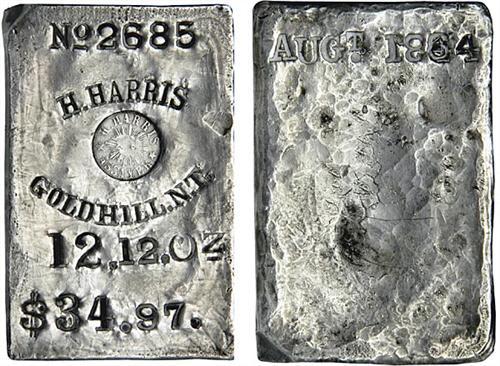
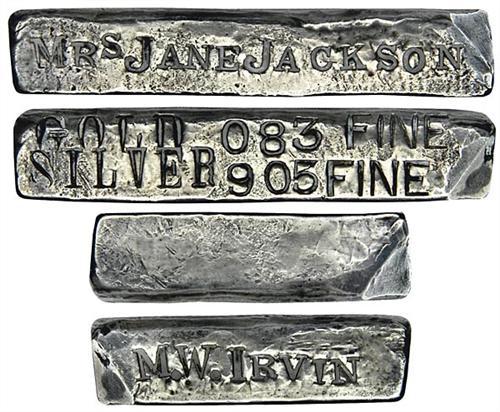
Overall appearance of Very Fine. A rather unprepossessing ingot. The piece is a light to medium silver color and has been cleaned at one time. The face and sides are rough, almost as made, with minimal polishing. The back has been ball-peened to make it smoother but still lacks polish. The sides have not been well finished, the edges are not sharp, and the corners were not well squared. This has the look of a work-a-day world ingot pressed into use as a presentation bar. The assayer’s name and location are in logotypes but whether they are one or two is uncertain. GOLD and SILVER were in logotypes. The opposing corners of this bar have been clipped for proof of assay. This bar bears Harris’ Gold Hill location and, most unusually, the letters N.T. for Nevada Territory.
When this bar made its first auction appearance the cataloguer incorrectly described Harvey Harris as a Jewish assayer. Dan Owens has more accurately shown Harris was gentile.
- Face: No.2685. / H.HARRIS / H. HARRIS / ASSAYER around an all-seeing eye [his assayer’s stamp] / GOLDHILL. N.T. / 12.12.OZ. / $34.97.
- Back: AUGT. 1864 (6 punched over 4).
- Top side: M.W. IRVIN.
- Bottom side: blank.
- Left side: GOLD 083 FINE / SILVER 905 FINE.
- Right side: MRS. JANE JACKSON.
- Dimensions: 67.3 x 44.8 x 12.0 mm.
- Stated weight: 12.20 ozs.
From the John J. Ford, Jr. Collection
Provenance: Ex Chris Schenkel Collection (Bowers & Merena, November 12, 1990, lot 4481).
[10/2007] https://auctions.stacksbowers.com/lots/view/3-AV6MF/harvey-harris-assayer-gold-hill-nevada-territory-silver-gold-presentation-assay-ingot-number-2685-august-1864 ($43,125)
The ingot has a lengthy story in “The Rush For Gold” (2008, pp106-110). It was given from M. W. Irvin to Jane Jackson, as indicated by the punch marks on the sides of the ingot. Irvin was working in Gold Hill in 1862. His name does not appear in the 1862, 1863 or 1864 Nevada directories, thus the possible conclusion that this is a late 1862 ingot, made just after Nevada Territory was established out of Utah Territory. The only Jane Jackson found in records is an African American worker.
[05/2016] https://holabirdamericana.liveauctiongroup.com/The-Top-1-Nevada-Silver-Ingot-Harvey-Harris-Gold-Hill_i24628401 (Passed)
[01/2017] https://auctions.morphyauctions.com/LotDetail.aspx?inventoryid=252707 ($14,400)
5.95 oz Harvey Harris, Assayer. Gold Hill or Silver City, Owyhee County, Idaho Territory. Silver & gold presentation assay ingot number 6226.
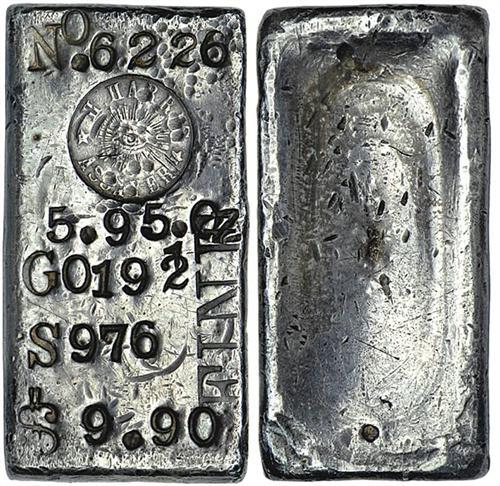
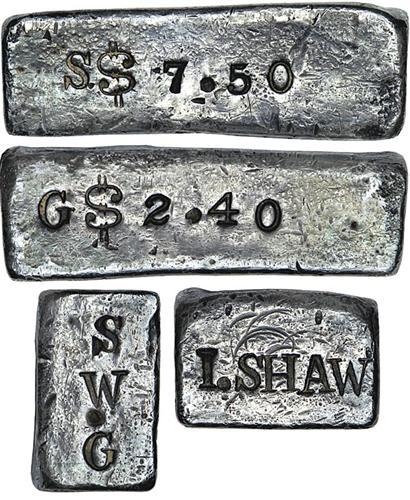
Overall appearance of Fine to Very Fine. A very rough looking ingot that would have been spent or melted at the time had it not been a presentation bar. The faces are rough and unfinished in places, the edges are not sharp, and the corners are not squared off. The cooling depression on the back has been smoothed down, however, showing some care was exercised when the bar was made. The punches are rather crude in appearance. OZ has been punched over the end of FINE on the face. The fraction in the gold fineness has been made by superimposing a 1 above a 2. Harris’ assayer’s stamp shows the distinctive incomplete H’s. Harris’ name appears on the bar only in this stamp, unlike the previous bar.
Face: No.6226 / H. HARRIS / ASSAYER around an all-seeing eye [his assayer’s stamp] / 5.95 OZ / FINE [vertically to right alongside next two] G 019 1/2 / S 976 / $9.90.
- Back: blank.
- Top side: S / W. / G.
- Bottom side: I. SHAW.
- Left side: G$ 2.40.
- Right side: S$ 7.50.
- Dimensions: 49.0 x 24.8 x 15.1 mm.
- Current weight: 185.8 gms
From the John J. Ford, Jr. Collection
Provenance: Ex Adelphia Stamp & Coin Company, Harry Forman, New Netherlands Coin Company on October 25, 1959, Paul Franklin on October 25, 1959.
[10/2007] https://auctions.stacksbowers.com/lots/view/3-AV6ML/harvey-harris-assayer-gold-hill-or-silver-city-owyhee-county-idaho-territory-silver-gold-presentation-assay-ingot-number-6226 ($32,200)
Nevada Territory. Silver City or Gold Hill. H. Harris, Assayer. 5.95 ounces. .976 fine silver. .0195 fine gold. 49.2 x 25.3 x 15.0 mm. Right face stamped G.$2.40, left face stamped S.$7.50, north face stamped S.W.G., south face stamped I. SHAW. Base of ingot shows cooling depression. Face of ingot marked with Harris’ unique seeing-eye touchmark, copied from the mark of former partner Desire Marchand and made famous by its use on some of the most valuable bars from the S.S. Central America. Serial number 6226.
This ingot’s contents make it nearly a monetary ingot, just 1% removed from being equal to a U.S. eagle and closer than nearly any other Harris ingot to this status. From its various marks and small dents, the sort seen on a circulated coin, this piece may well have been used in commerce. The ANS has a nearly monetary ingot from Harris’ shop, valued at $2.55.
This ingot appears to be one of just six Harvey Harris bars in private hands and, importantly, one of just two with his famous touchmark. The first appearance of a Harvey Harris bar in numismatic circles appears to be in Thomas Elder’s June 1909 sale. In 1911, the famed numismatist Edgar Adams described a different Harris bar in The Numismatist. Those bars punch link to this bar, as does the one placed in the ANS collection in 1939. Even the noted skeptic John Kleeberg has stated in print that the Harris bars are “well authenticated.” He further noted, in attempting to formulate a standard to prove the authenticity of western ingots, that “One method to authenticate a silver bar is to find a pre-1950 photograph. This has been possible with one maker: Harvey Harris (Adams 1911). All Harvey Harris bars seen punchlink with this bar, so they are all authentic.” This was one of just two Harris bars in the Ford Collection. With most attention of ingot collecting pointed towards the bars of the S.S. Central America, it is useful to point out that only Harris and F.W. Blake, among all the assayers who made ingots present in the Ford sale, had a direct hand in the production of ingots that sunk on the “Ship of Gold.” This extremely rare and visual Harris ingot is one of the stars of the present offering.
[07/2009] https://auctions.stacksbowers.com/lots/view/3-B2LH6/nevada-territory-silver-city-or-gold-hill-h-harris-assayer-595-ounces-976-fine-silver-0195-fine-gold (Passed)
NV – Gold Hill,Storey County – c 1861-2 – Harris, Harvey, Assayer, Silver & Gold Presentation Assay
This is a rougher looking ingot with an unfinished appearance measuring approximately 1 x 1.75 x .5” and weighs 185.8 grams. Obverse is stamped: No. 6226 / HARRIS / ASSAYER [Harris’s assayer’s stamp] /5.95 OZ /FINE [printed vertically along the right edge]; the reverse is blank with a cooling depression that has been smoothed down; the top is stamped: S. / W. /G.; the bottom is stamped: I. Shaw; the left side is stamped: G$ 2.40; the right side is stamped: S$ 7.50.
This wonderful ingot was one of at least two different ingots presented from Simon W. Glazier, hence the “S.W.G.” on one side. Glazier was a client of Harris’ in Marysville. The second ingot of his was a gold ingot in the Bass Collection. Glazier was a mine financier and manager, and I. Shaw, was a young man probably working in Marysville or thereabouts in the mid 1860s. He was born in 1842, and by 1880 had moved north to Tehama, where he was a farmer. There is also a bullion receipt and related correspondence form Glazier in the Marysville Section of this catalog. This ingot is probably from Harris’s Marysville office c 1861-2. The reasons for this evaluation are that A) Simon Glazier was a known client out of Marysville and B) There is no IRS bullion tax stamp on the ingot, which means it must pre-date June 1863. After Harris moved to Gold Hill he probably punched the town name into the ingot.
[06/2011] https://www.icollector.com/NV-Gold-Hill-Storey-County-c-1861-2-Harris-Harvey-Assayer-Silver-Gold-Presentation-Assay_i10679417 ($35,250)
3.30 oz A “Mistake” Harvey Harris Ingot, Gold Hill, NT
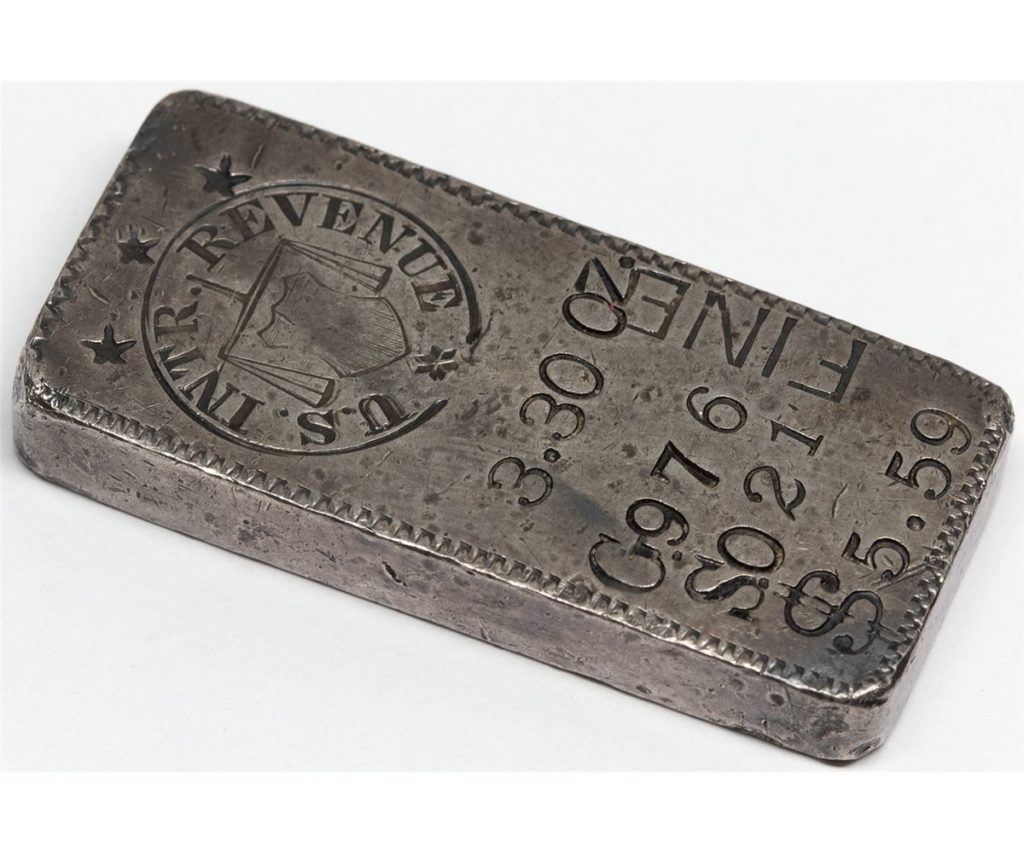
1 x 2″, Internal Revenue Tax punch at top center, Three stars above. 3.30 ozs/ G976/ S021/ $5.59/ FINE.
Irregular wavy line pattern around obverse and reverse. Blank reverse. High polish. This silver ingot was made to be a presentation ingot. It is very highly polished on both sides prior to punching, as well as fancily engraved along the edges front and back prior to punching. It dates from the period 1863 to about 1868, based upon the federal Tax Stamp (punch). But there is much to learn from this ingot, which I don’t believe has seen public record.
First, the engravings along the outside edges of both sides are indicative of Assayer Harvey Harris, though at least one Wiegand ingot has similar traits. Second, the ingot engraving was never completed. There is a reason: Comstock ingots are usually reported with the higher value first, which is silver. Thus the value reported would have been silver, then gold. Here, the assayer marking the ingot made a mistake, and put “G” for gold on top, with the attendant silver fineness of 976. If this were indeed 976 fine gold, the color of the ingot would be gold. It is clearly silver color, thus the number placement is reversed. The “S” for silver under the gold fineness is 021 fine, which matches very closely the average Comstock gold content for these little silver ingots. Thus the fineness is reversed. This is verified by the total dollar value of the ingot ($5.59), which only matches a silver fineness of 976. Once this mistake was realized, the maker had to start over, and would have discarded this ingot. One could speculate that the ingot was made in 1863, and that assayer Harris got confused after having worked on gold so much at his Marysville office, and perhaps was just back to Gold Hill after a trip to his Marysville office.
[09/2014] https://holabirdamericana.liveauctiongroup.com/A-Mistake-Harvey-Harris-Ingot-Gold-Hill-NT_i20352922 ($3,100)
5.0 oz 1860’s Nevada Silver Bar, $10.48 value, Harvey Harris

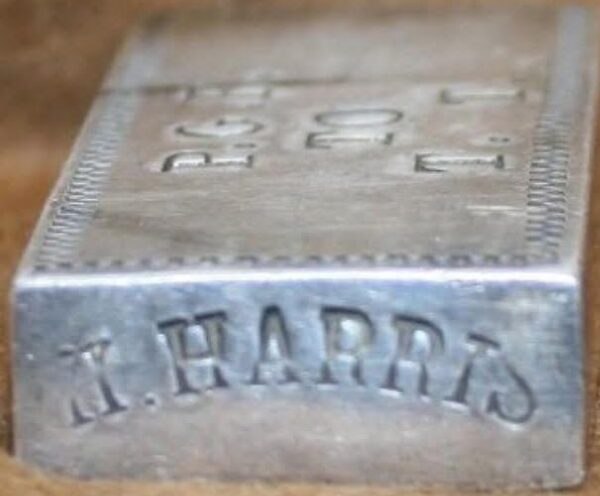
Consistent in style with other Harvey Harris ingots, this one weighs in at 5.0 oz exactly. Gold 040 Fine, Silver 952 Fine, with a total value of $10.48 monetized.
Edge reads: H. Harris
Reverse: PGB? To T. ?
We have not located a public auction record for this piece yet.
2.02 oz 1860’s Nevada Silver Bar, $3.66 value, unmarked.
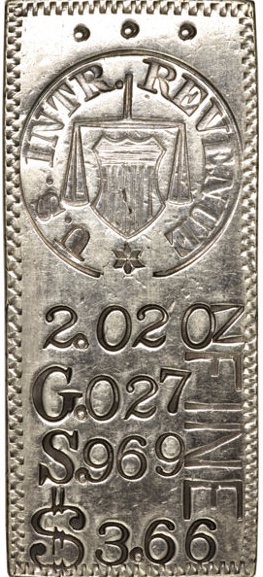
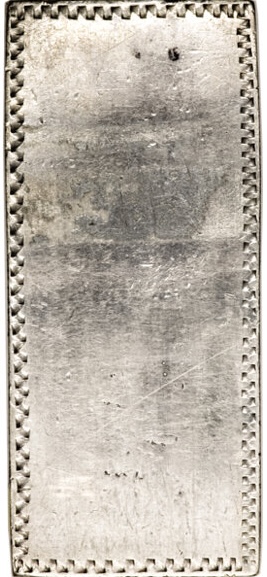
NOTE: We attribute this bar to Harvey Harris at this time based on patterns of previous ingot listed above.
58.1 gm. 48.4 x 21.3 x 5.3 mm. This bar previously appeared as lot 1614 in the January 2001 Stack’s auction, where it was described as “Extremely Fine. The front bears the U.S. Internal Revenue seal at the top. Below are the bar’s weight in ounces as 2.02 OZ; its gold fineness as G.027; its silver fineness as S.959; and its value in dollars and cents as $3.66. Along the right side is FINE placed sideways. The whole side is enclosed by an ornamented border. The four short sides are all blank. The back is blank, now, but at one time probably held the assayer’s name and possibly also a date, leaving only the border ornamentation.
The Internal Revenue seal was ordered to be stamped onto all bars of assayed bullion following payment of a Federal tax assessed on the value of the bullion. The law went into effect on June 30, 1864, and was not lifted until the 1870s, after which assayed bars no longer needed to be stamped. Thus, despite the lack of a maker’s name and date, this bar can certainly be dated after June 30, 1864, and before the 1870s. The exact date the law was repealed has not yet been found.” This small steel-gray ingot is ideal for the Western collector who desires unique and irreplaceable items.
[08/2008] https://coins.ha.com/itm/ingots/undated-unparted-nevada-bar-pcgs-10373-/a/1114-3480.s ($5,500)
Unparted Ingot, likely by Assayer Harvey Harris. Gold Hill or Silver City, Nevada. ca. 1864-1872. 43.5 x 16.2 x 0.41 mm. Current Weight: 58.2 grams. Choice Extremely Fine.
Light silver surfaces have been lightly cleaned in the past, though deeper gray toning in the recesses nicely accentuates the design. Plain and smooth on the reverse, with one area of light surface oxidation. Sides are plain, though the top edge exhibits file marks and may have once featured the maker’s mark, though this is only supposition. One shallow fissure in the shield device is evidence that this side bore the original cooling depression, which was largely smoothed away before the mark was finished. Neatly ornamented around the periphery on both the face and back, with the usual fineness markers on the face. The presence of the U.S. Internal Revenue tax stamp dates the bar to 1864-1872, when Harvey Harris is known to have been operating in Gold Hill (1864-1870) and/or Silver City (1868-1877), Nevada. Authenticity of assay bars is a common concern, so we present evidence here that this bar is, in fact, genuine. We are aware of two bars bearing the Harris name that have been marked with the U.S. Internal Revenue tax stamp (others exist without the stamp, which predate the requirement of the stamp’s use, including the famous Harris and Marchand bars from the wreck of the S.S. Central America). One of those bars was published by Edgar H. Adams in 1911, so we know that piece is authentic. It appeared in Part 21 of the John J. Ford, Jr. Sales at lot 3517. The tax stamp on this bar is an identical match to that seen on the Adams bar, and it is distinctive from other such marks seen in that it is missing a section of the circular border at the base. Close examination of other elements reveal these to be from the same punch. In addition, the dollar sign used on both of these bars is from the same punch, though it has been applied directly upside down on one bar. The “S” punch, indicating silver, is also identical on both bars. Other punches differ somewhat, but the detailed evidence in what matches is unmistakable and speaks to an attribution of this unnamed bar to Harvey Harris.
The other referenced bar by Harris bearing the Internal Revenue tax stamp appeared in our June 1997 sale. It was also marked “H. HARRIS.” The tax stamp is once again a direct match to the present bar, as is the dollar sign (here punched just as it is on the present bar). Other similarities may be found in the digit “9”, the unusual sans-serif logotype FINE punch and the sans-serif style in the “OZ” punches.
Provenance: From our (Stack’s) Americana Sale of January 2001, lot #1614. Lot tag included.
Silver City,NV – Lyon County – June, 1860 – Harris Silver Presentation Ingot
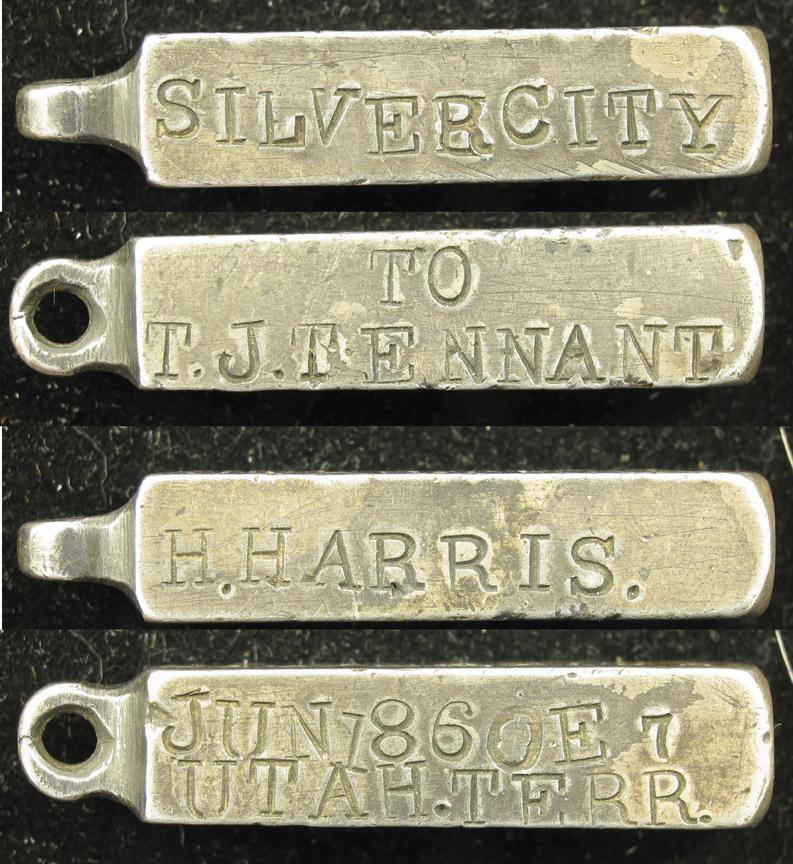
This miniature Comstock Lode silver ingot was made as a presentation watch fob. H. Harris, who made the ingot, began as an assayer in Marysville, California in 1855. After moving to Silver City he became active in the early development of the Comstock Lode.
The fob commemorates the organization of the “Devil’s Gate” Mining District and was presented to Thomas J. Tennant, who was active in establishing the district laws. The ingot reads “Silver City” and “June 1860, Utah Terr.” (At the time the Comstock Lode remained part of Utah Territory.) This is one of the earliest examples of Comstock Lode silver.
[10/2010] https://www.icollector.com/Silver-City-NV-Lyon-County-June-1860-Harris-Silver-Presentation-Ingot_i9800334 ($24,675)
2.6 oz California. Sacramento. Undated H. Harris Silver Ingot. Without Serial Number. .950 Silver. Face Value: $5.60
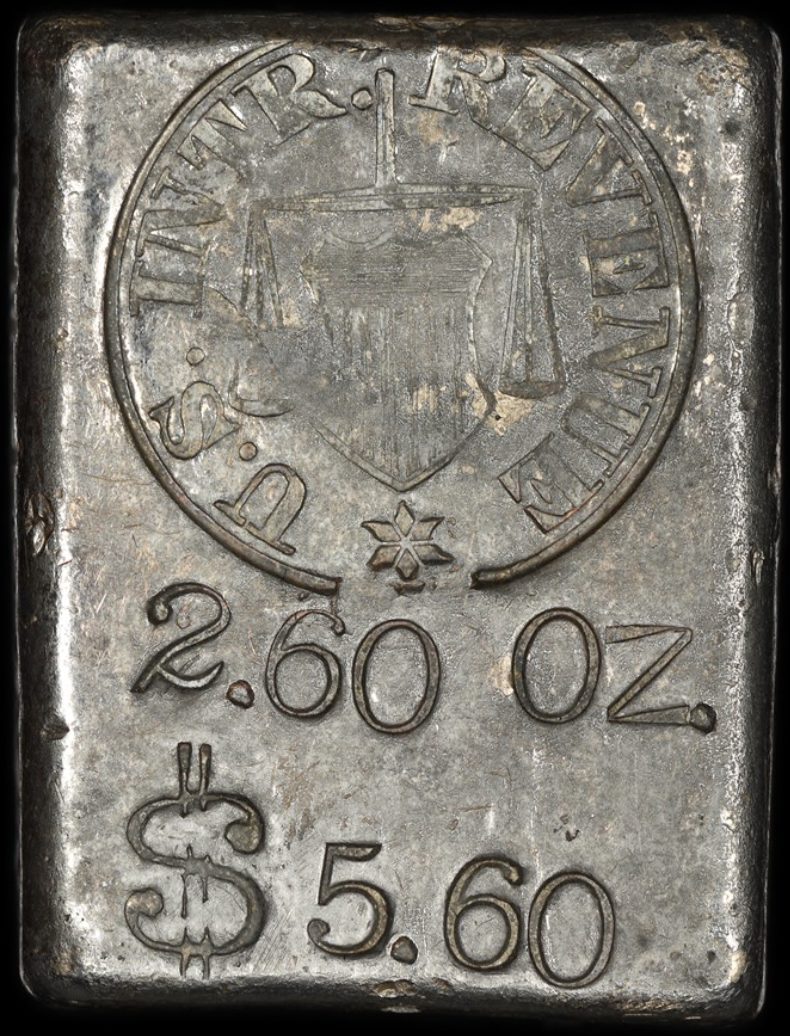
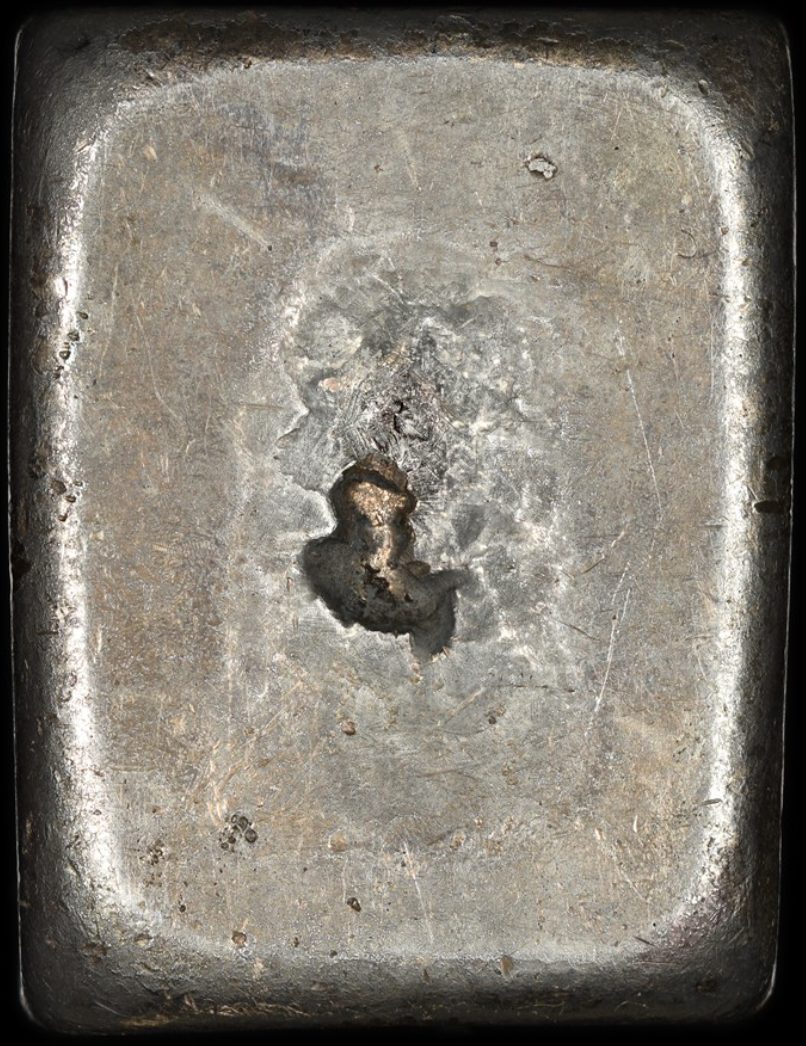
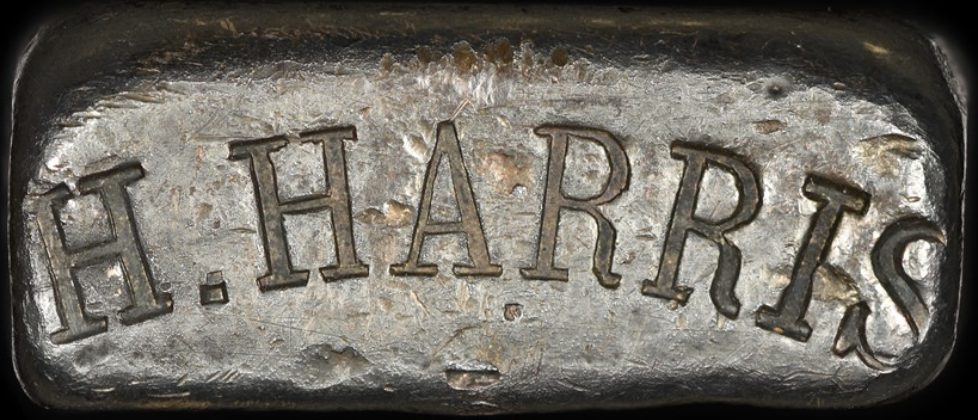
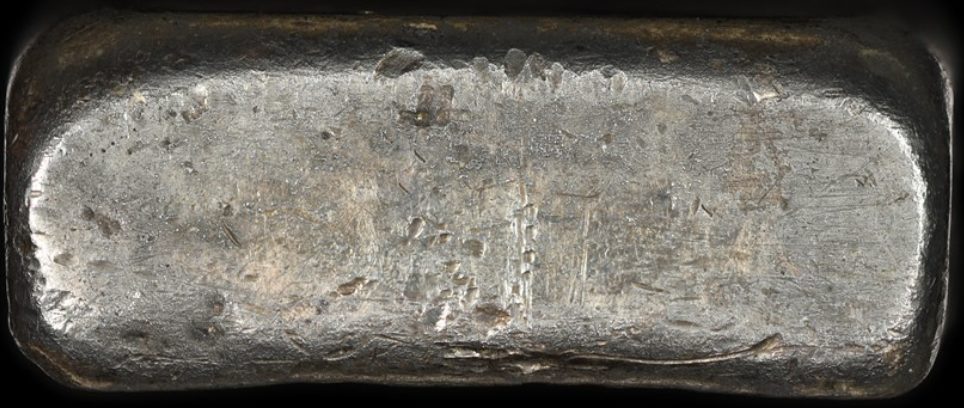
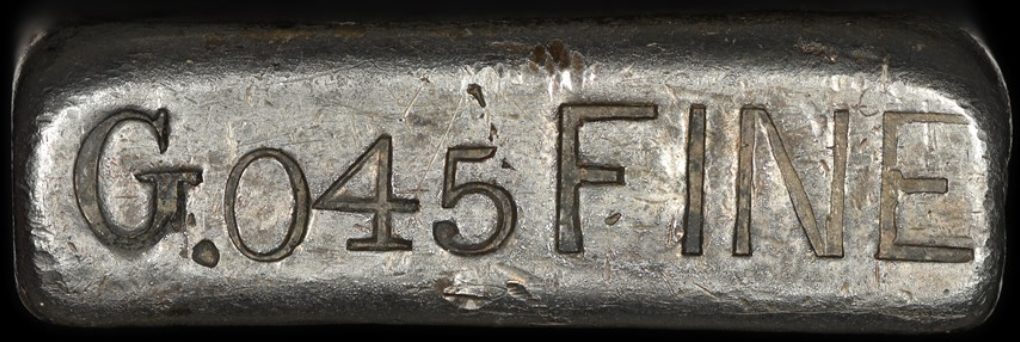

This deep slate grey link to the heady times of old California. Impressed on the face and three edges, with no impressions on the top edge or back. Harris was a partner in Harris, Marchand & Co. at one time. The IRS stamp boldly imprinted on the face was reportedly used only circa 1863-1867.
The bar is stamped with the round Internal Revenue stamp, the weight, 2.60 ounces, and the value $5.60. The top edge ts stamped H. Harris. The long edges (not shown) are stamped with the bar’s gold (.045) and silver (.950) finenesses.
[09/2017] https://www.icollector.com/California-Sacramento-Undated-H-Harris-Silver-Ingot-Without-Serial-Number-2-60-Ounces-950-Sil_i27907302 ($12,925)
A remarkable piece of Comstock Lode history, this ingot represents the work of Harvey Harris, one of the most prominent and pioneering assayers of the American West.
- Weight: 2.60 ounces
- Value at time of casting: $5.60
- Gold fineness: .045
- Silver fineness: .950
- Origin: Gold Hill or Silver City, Nevada
- Notable: Bears IRS stamp
Harvey Harris, a Danish immigrant, played a pivotal role in the development of assaying in California and Nevada during the Gold Rush era. After working at the New Orleans and San Francisco Mints, Harris established his own assay offices, eventually expanding to the booming Comstock Lode region.
This ingot likely dates from the 1860s, when Harris had offices in Aurora, Carson City, Silver City, and Gold Hill. The presence of the IRS stamp adds an intriguing element, speaking to the government’s efforts to regulate and tax precious metal production during this period.
Harris’s career spanned the most exciting years of Western mining history. He arrived in California at the height of the Gold Rush, adapted his business to the silver boom of the Comstock Lode, and served as Vice Consul to Denmark for Nevada for nearly three decades.
The high silver content (95%) with a small amount of gold (4.5%) is typical of Comstock ore, offering a tangible connection to one of the richest silver strikes in American history.
Harris Ingots are considered extremely rare! To date we have only been able to identify 7 that we believe are genuine.
[08/2024] https://bidnow.vegascoindealer.com/Event/LotDetails/251510/Rare-Harvey-Harris-Assayer-Ingot-with-IRS-Stamp-Nevada-c-1860s ($39,050)
